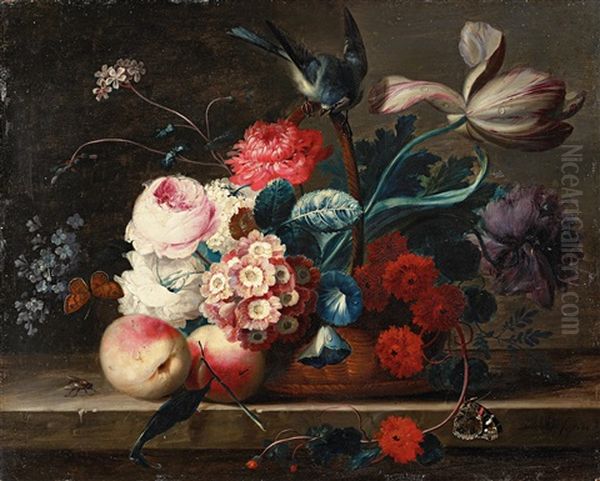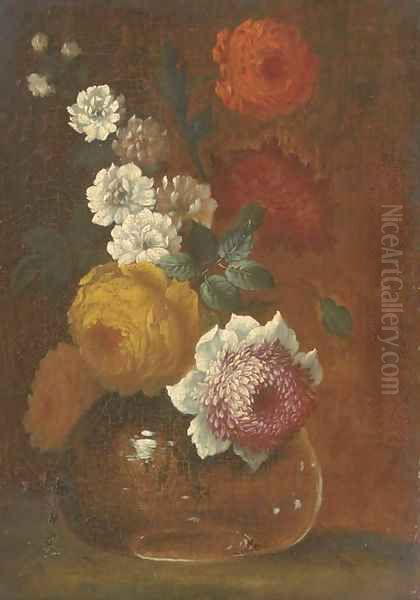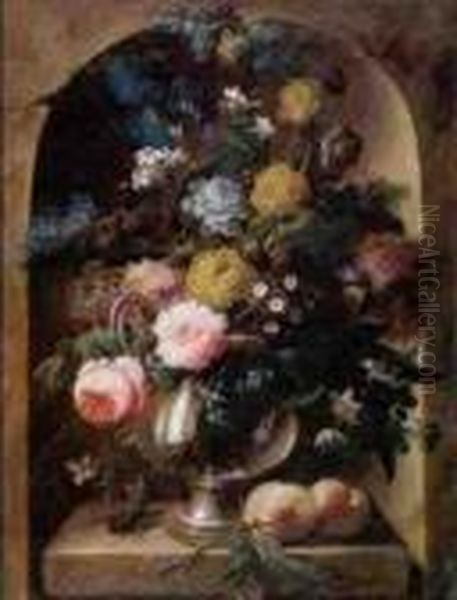Johann Baptist Drechsler stands as a pivotal figure in the history of Austrian art, particularly celebrated for his mastery of flower painting during the late 18th and early 19th centuries. Born in Vienna in 1756 and passing away in the same city in 1811, Drechsler carved a significant niche for himself, elevating the genre of still life, especially floral compositions, to new heights within the Viennese art scene. His career bridged the gap between artisanal craft and fine art, and his influence extended significantly through his role as a professor and later director at the prestigious Vienna Academy of Fine Arts. His legacy is defined by technically brilliant, aesthetically rich paintings and the generation of artists he inspired.
Early Life and Foundations in Craft
Johann Baptist Drechsler's artistic journey began in an environment steeped in craftsmanship. Born into the family of a porcelain painter, he was exposed early on to the demands of detailed decorative work. Vienna, during his formative years, was a major center for luxury goods, and the Imperial Vienna Porcelain Manufactory was renowned for its quality. It was here, between approximately 1772 and 1782, that Drechsler received his initial training and professional experience. Working as a porcelain painter provided him with an invaluable foundation, honing his skills in precise drawing, delicate application of color, and the creation of balanced, often intricate compositions suitable for decorating fine ceramics.
This period was crucial. Painting on porcelain requires immense control and an understanding of how pigments behave under firing. It demands clarity of line and form, often on curved surfaces, fostering a discipline that would later translate into the meticulous detail seen in his easel paintings. The decorative nature of porcelain design also likely influenced his approach to composition, emphasizing visual appeal and harmonious arrangement, characteristics that would become hallmarks of his celebrated floral still lifes. While he eventually moved beyond the confines of the manufactory, this early immersion in applied arts undoubtedly shaped his artistic sensibilities and technical prowess.
The Transition to Fine Art and Dutch Influences

Sometime after his tenure at the porcelain manufactory, Drechsler made a decisive shift towards fine art, focusing primarily on oil painting and watercolor. This transition allowed him greater freedom in scale, complexity, and medium. It was during this phase that the profound influence of Dutch Golden Age masters became evident in his work. The 17th-century Dutch Republic had witnessed an unprecedented flourishing of still life painting, with artists achieving remarkable levels of realism and compositional sophistication.
Drechsler looked particularly to the legacy of painters like Jan van Huysum (1682-1749), a later Dutch master renowned for his incredibly detailed, luminous, and often opulent flower arrangements. Van Huysum's style, characterized by bright lighting, smooth finish, intricate detail (including dewdrops and insects), and complex bouquets often set against light backgrounds or classical garden settings, resonated deeply with Drechsler. The Austrian artist adopted and adapted this meticulous approach, striving for a similar level of verisimilitude and decorative richness.
Other Dutch and Flemish masters of still life, such as Rachel Ruysch (1664-1750), known for her dynamic compositions and dark backgrounds, Jan Davidsz. de Heem (1606-1684), celebrated for his lavish "pronkstilleven" (ostentatious still lifes), and earlier pioneers like Ambrosius Bosschaert the Elder (1573-1621), who often depicted flowers with botanical accuracy, collectively formed the rich tradition upon which Drechsler built. While van Huysum appears to be the most direct influence, Drechsler operated within this broader historical context of Northern European still life excellence.
Drechsler's Distinctive Artistic Style
While heavily indebted to Dutch precedents, Johann Baptist Drechsler developed a style that was distinctly his own, tailored to the tastes of late 18th and early 19th century Vienna. His paintings are characterized by an extraordinary level of detail and realism. Each petal, leaf, stem, and even the occasional insect is rendered with painstaking care, showcasing a profound observational skill and technical virtuosity likely honed during his porcelain painting years. He achieved a remarkable illusion of texture, capturing the velvety softness of rose petals, the delicate translucency of grape skins, or the cool smoothness of a marble ledge.
His compositions are typically abundant and complex, often described as luxurious or even opulent. He favored arranging a wide variety of flowers into dense bouquets, frequently combining species that bloom in different seasons. This practice, common among specialized flower painters like van Huysum, created an idealized vision of nature's bounty, prioritizing aesthetic harmony over strict botanical chronology. These arrangements were often placed in ornate vases, urns, or baskets, sometimes situated within architectural niches or resting on stone ledges, adding depth and context to the composition.

Drechsler's use of color was vibrant and sophisticated. He employed a rich palette, skillfully balancing warm and cool tones to create a sense of harmony and luminosity. Light plays a crucial role in his work, often illuminating the bouquet dramatically against a darker, more subdued background, making the flowers appear almost radiant. While rooted in Baroque traditions of realism and drama, his work sometimes exhibits Rococo elements in its elegance, intricate detail, and occasionally lighter, more decorative feel, reflecting the transitional artistic period in which he worked.
Masterworks and Signature Motifs
Among Drechsler's most celebrated works is the painting often titled Bouquet of Flowers in a Stone Vase or similar variations. These compositions exemplify his mature style. Typically, they feature an elaborate stone vase overflowing with an impressive array of flowers – roses, tulips, peonies, carnations, irises, morning glories, and many others, rendered with exquisite detail. The careful arrangement creates a sense of controlled abundance, with flowers seemingly spilling forward towards the viewer.
These works often include meticulous details beyond the main floral subject. Tiny insects like butterflies, ladybugs, or flies might alight on petals or leaves, adding a touch of life and enhancing the illusion of reality, a motif directly borrowed from Dutch masters like van Huysum. Dewdrops clinging to surfaces further demonstrate the artist's technical skill. The settings are also rendered with care, whether it's the veining of a marble ledge or the texture of the stone vase itself. These elements contribute to the overall richness and verisimilitude of the scene.
Another known work, Vase with Butterflies and Roses, highlights his focus on specific floral types and the inclusion of delicate natural elements. His repertoire consistently revolved around these themes: the beauty and diversity of the floral world, captured with scientific precision yet arranged for maximum aesthetic impact. The combination of different flower types, textures, and colors, along with the interplay of light and shadow, creates works that are both visually stunning and technically masterful. These paintings were highly sought after by patrons who appreciated their decorative quality and the skill they represented.
A Leading Role at the Vienna Academy
Drechsler's significance extends beyond his own artistic output; he played a crucial role in shaping the next generation of Viennese artists. In 1787, his expertise was formally recognized when he was appointed the first professor of the newly established flower painting class (Blumenmalereischule) at the Vienna Academy of Fine Arts (Akademie der bildenden Künste Wien). This appointment was significant, as it institutionalized the teaching of flower painting as a distinct discipline within the prestigious academy.

His role as an educator was profoundly influential. He instilled in his students the meticulous techniques and aesthetic principles derived from his own practice and his study of Dutch masters. He emphasized careful observation of nature, precise rendering, and sophisticated composition. His teaching helped establish a strong tradition of flower painting in Vienna that would flourish well into the 19th century, particularly during the Biedermeier period.
Later in his career, Drechsler's standing within the Academy grew further. After 1807, he served as the director of the Academy, a position that underscored his esteemed reputation within the Viennese art establishment. His leadership role, combined with his long tenure as a professor, cemented his legacy not just as a painter, but as a central figure in the artistic education and cultural life of Vienna at the turn of the 19th century.
Notable Students and the Biedermeier Legacy
Through his position at the Vienna Academy, Johann Baptist Drechsler directly influenced several artists who would become prominent figures in their own right, particularly within the context of the Biedermeier era (roughly 1815-1848). Among his most notable students were Josef Nigg (1782-1863) and Franz Xaver Petter (1791-1866). Both artists absorbed Drechsler's emphasis on technical precision and detailed realism but adapted it to the evolving tastes of the Biedermeier period.
Josef Nigg became highly renowned not only for his easel paintings but also for his exquisite flower painting on porcelain, continuing the tradition Drechsler himself had started in. Nigg's works often display an even greater level of botanical accuracy and sometimes a smoother, more polished finish characteristic of the Biedermeier aesthetic. Franz Xaver Petter also achieved considerable success, known for his rich, detailed floral compositions that carried forward Drechsler's legacy of abundance and technical skill, often imbued with the slightly more sentimental or decorative quality favored during the Biedermeier period.
The Biedermeier era in Vienna emphasized realism, domesticity, technical proficiency, and often a certain quiet intimacy. While Drechsler's work retained elements of Baroque grandeur and Rococo elegance, his focus on meticulous observation and realistic rendering provided a direct bridge to the Biedermeier sensibility. Artists like Ferdinand Georg Waldmüller (1793-1865), though primarily known for portraits and landscapes, exemplified the Biedermeier commitment to realism, a value Drechsler championed in his specific genre. Drechsler's teaching thus laid crucial groundwork for the development of this significant period in Austrian art. Other flower painters, like Pauline von Koudelka-Schmerling (1806-1840), also worked within this tradition influenced by the standards set at the Academy.
The Viennese Art Scene in Drechsler's Time
Johann Baptist Drechsler worked during a dynamic period in Viennese and European art history. The late 18th century saw the waning influence of the late Baroque and Rococo styles, which had flourished under Empress Maria Theresa. Artists like Franz Anton Maulbertsch (1724-1796) and Martin Johann Schmidt (known as Kremserschmidt, 1718-1801) were masters of the exuberant, painterly styles associated with this earlier era, particularly in large-scale frescoes and altarpieces.
However, the Enlightenment brought a growing interest in reason, nature, and clarity, which began to influence artistic trends. Neoclassicism, with its emphasis on order, classical forms, and moral seriousness, gained prominence across Europe. In Vienna, artists like Heinrich Friedrich Füger (1751-1818) became leading proponents of this style, particularly in historical and mythological subjects and portraiture. Johann Peter Krafft (1780-1856) would later bridge Neoclassicism and the emerging Biedermeier style in his historical paintings.
Drechsler's specialized genre of flower painting occupied a unique position within this shifting landscape. While still life did not hold the same hierarchical status as history painting, its appeal to patrons seeking decorative beauty and demonstrations of technical skill remained strong. Drechsler's work, with its blend of meticulous realism (aligning with Enlightenment interests in observation) and decorative opulence (appealing to aristocratic and bourgeois tastes), successfully navigated these changing currents. He provided a continuation of established traditions (Dutch Baroque) while adapting them to contemporary Viennese sensibilities, paving the way for the Biedermeier focus on detailed representation of the natural world.
European Context: Flower Painting Contemporaries
While Drechsler was the preeminent flower painter in Vienna, the genre was practiced with distinction elsewhere in Europe during his time. In France, for instance, artists continued the tradition of elegant floral still lifes. Anne Vallayer-Coster (1744-1818) was a highly respected painter known for her versatile still lifes, including floral arrangements, which often possessed a refined, almost intimate quality. She, like Drechsler, gained academic recognition (member of the French Royal Academy).
Another significant figure, particularly influential through his position at the Jardin des Plantes in Paris, was Gerard van Spaendonck (1746-1822). Of Dutch origin but working primarily in Paris, van Spaendonck was renowned for both his oil paintings and his watercolors on vellum, which combined botanical accuracy with artistic elegance. His work, like Drechsler's, showed the enduring influence of the Dutch masters but adapted to the Neoclassical taste for clarity and precision. Comparing Drechsler to these contemporaries highlights the shared European interest in the genre, rooted in Dutch traditions but evolving according to regional tastes and broader stylistic shifts towards Neoclassicism and detailed realism. Drechsler's specific contribution lies in his central role within the Viennese context and his direct pedagogical lineage.
Later Life, Death, and Enduring Legacy
Johann Baptist Drechsler remained active as an artist and educator into the early 19th century. His position as Director of the Vienna Academy of Fine Arts from 1807 onwards marked the culmination of his career, signifying his high standing in the city's artistic hierarchy. He continued to paint his signature floral compositions, maintaining a high standard of quality and detail.
He passed away in Vienna in 1811 at the age of 55. His death marked the end of a significant chapter in Viennese art, but his influence endured. Through his own extensive body of work and, perhaps more importantly, through the students he trained, Drechsler left an indelible mark on Austrian art history. He effectively established the Vienna school of flower painting, characterized by technical brilliance, detailed realism, and often luxurious composition.
His works continued to be appreciated after his death and found their way into important collections. Today, paintings by Johann Baptist Drechsler are held in major museums, including the Kunsthistorisches Museum in Vienna and the Hermitage Museum in St. Petersburg, among others. These holdings attest to his contemporary reputation and his lasting significance as a master of the still life genre. His legacy lies in his ability to synthesize the meticulous traditions of Dutch Golden Age painting with the specific cultural and aesthetic environment of late 18th and early 19th century Vienna, creating works of enduring beauty and technical accomplishment.
Art Historical Evaluation and Conclusion
In the grand narrative of art history, Johann Baptist Drechsler is recognized primarily as a specialist, a master within the specific genre of flower painting. While perhaps not as revolutionary as figures who transformed major genres like history painting or portraiture, his contribution within his chosen field was substantial and highly influential, particularly within the Austrian context. He represents the pinnacle of Viennese flower painting at the turn of the 19th century.
His key achievements include successfully adapting the highly refined techniques of Dutch masters like Jan van Huysum to Viennese tastes, creating works that were both incredibly realistic and highly decorative. He elevated the status of flower painting within the Vienna Academy through his dedicated professorship and eventual directorship, establishing a formal pedagogical tradition for the genre. Furthermore, he trained key artists like Josef Nigg and Franz Xaver Petter, ensuring the continuation and evolution of this tradition into the subsequent Biedermeier period.
Drechsler's paintings are admired for their technical virtuosity, their vibrant celebration of nature's beauty (albeit an idealized one), and their sheer visual appeal. They reflect the era's interest in botanical observation while simultaneously serving as objects of luxury and refinement. As an artist who bridged the worlds of craft and fine art, and who played a central role in artistic education, Johann Baptist Drechsler holds a secure and respected place in Austrian art history as Vienna's foremost flower painter of his time. His luminous bouquets continue to captivate viewers with their intricate detail and timeless elegance.